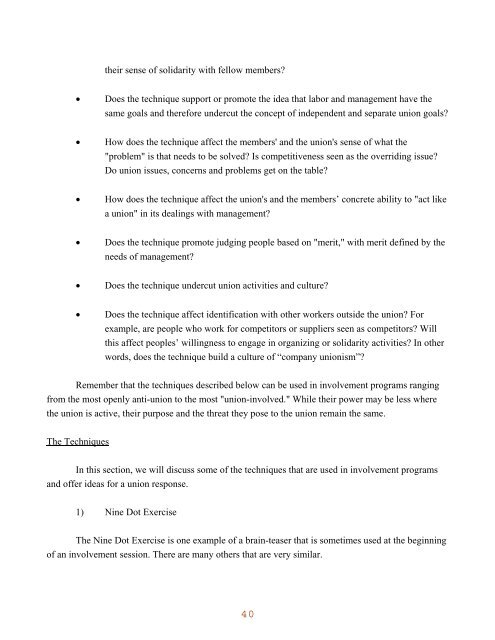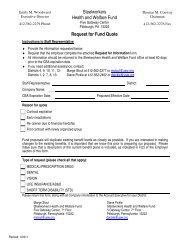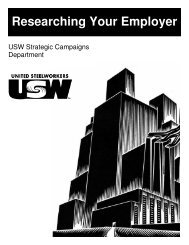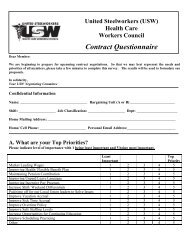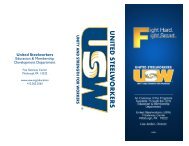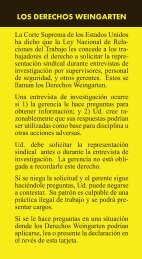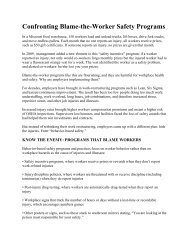- Page 1: Union Approach to Health and Safety
- Page 4 and 5: Activity Handout: Goals for Workpla
- Page 6 and 7: Activity Worksheet: Planning for a
- Page 8 and 9: (This page left intentionally blank
- Page 10 and 11: 3. Why did this problem get correct
- Page 12 and 13: Activity Handout: Impacts of Workpl
- Page 14 and 15: involvement groups or teams. Genera
- Page 16 and 17: discourage workers from reporting i
- Page 18 and 19: References Aiken, L.H., Clarke, S.P
- Page 20 and 21: National Institute for Occupational
- Page 22: High levels of monthly overtime (84
- Page 30 and 31: Multi-skilling Multi-tasking Flexib
- Page 32 and 33: All of these trends have negative i
- Page 34 and 35: Arenas of Struggle: Where Managemen
- Page 36 and 37: Introduction In 1993, the USWA init
- Page 38 and 39: substance of collective worker powe
- Page 40 and 41: Management is seeking to create a p
- Page 42 and 43: "rubber hits the road," in the actu
- Page 44 and 45: would with a management facilitator
- Page 48 and 49: People are told that the reason tha
- Page 50 and 51: Lost in the Desert is one of severa
- Page 52 and 53: include: * Success and failure are
- Page 54 and 55: In the workplace, where management
- Page 56 and 57: 1) that everything that happens in
- Page 58 and 59: impacts of changes while ignoring l
- Page 60 and 61: include: How does the appearance of
- Page 62 and 63: Ideas for Acting Like a Union: Make
- Page 64 and 65: Involvement programs often utilize
- Page 66 and 67: waste as management defines it incl
- Page 68 and 69: A favorite trick of involvement con
- Page 70 and 71: A flip chart and magic marker are o
- Page 72 and 73: Please send comments and suggestion
- Page 74 and 75: consultant is claiming that they ha
- Page 76 and 77: Where will the data be stored? What
- Page 78 and 79: Questions about New Work Systems an
- Page 80 and 81: What is the anticipated impact of t
- Page 82 and 83: (This page left intentionally blank
- Page 84 and 85: 2. Often the main problem with safe
- Page 86 and 87: What Is The Most Effective Way To P
- Page 88 and 89: In any investigation of an injury,
- Page 90 and 91: (This page left intentionally blank
- Page 92 and 93: tasks at ground level rather than w
- Page 94 and 95: (This page left intentionally blank
- Page 96 and 97:
Some people thought that this prove
- Page 98 and 99:
design a simple health and safety s
- Page 100 and 101:
ACTIVITY HANDOUT GOALS FOR WORKPLAC
- Page 102 and 103:
(This page left intentionally blank
- Page 104 and 105:
United Steelworkers Health, Safety
- Page 106 and 107:
United Steelworkers Health, Safety
- Page 108 and 109:
8) The union members of the joint c
- Page 110 and 111:
(This page left intentionally blank
- Page 112 and 113:
Activity Handout: COLOR-CODE FOR WO
- Page 114 and 115:
Activity Handout COLOR-CODE FOR WOR
- Page 116 and 117:
To create a body map, you need the
- Page 118 and 119:
A set of “sticky dots” in 6 dif
- Page 120 and 121:
Example of Life Map in Progress Ask
- Page 122 and 123:
Activity Handout COLOR-CODE FOR WOR
- Page 124 and 125:
4. Why did you choose this particul
- Page 126 and 127:
(This page left intentionally blank
- Page 128 and 129:
STEP #1: IDENTIFY THE SURVEY TOPIC
- Page 130 and 131:
those being surveyed care about ano
- Page 132 and 133:
time, and so on. These are consider
- Page 134 and 135:
(This page left intentionally blank
- Page 136 and 137:
(This page left intentionally blank
- Page 138 and 139:
Access to Exposure and Medical Reco
- Page 140 and 141:
• The names of chemical hazards i
- Page 142 and 143:
Sample Request Letter to Employer f
- Page 144 and 145:
Workers and/or unions who request i
- Page 146 and 147:
There can be a charge for these cop
- Page 148 and 149:
equired to provide the union with i
- Page 150 and 151:
(This page left intentionally blank
- Page 152 and 153:
• The NLRB usually defers to the
- Page 154 and 155:
Calling For An Inspection If you wa
- Page 156 and 157:
equires it. In practice, most emplo
- Page 158 and 159:
OSHA Citations OSHA may choose to i
- Page 160 and 161:
desire to participate in any formal
- Page 162 and 163:
you with OSHA. Separate or private
- Page 164 and 165:
OSHA has 15 days to grant or deny t
- Page 166 and 167:
What Injuries/Illnesses Must The Em
- Page 168 and 169:
Privacy and Recording Injuries and
- Page 170 and 171:
USES AND LIMITATIONS OF OSHA 300 LO
- Page 172 and 173:
594 Miscellaneous Shopping Goods St
- Page 174 and 175:
3. How could you go about getting t
- Page 176 and 177:
(This page left intentionally blank
- Page 178 and 179:
2. Number of labor and management r
- Page 180 and 181:
7. Preparing for joint labor-manage
- Page 182 and 183:
Who Serves on Local Union Health an
- Page 184 and 185:
Identifying and communicating with
- Page 186 and 187:
work on improving safety and health
- Page 188 and 189:
Some joint labor-management health
- Page 190 and 191:
in member-involving ways, using uni
- Page 192 and 193:
e. If not, what additional training
- Page 194 and 195:
. If you answered “Yes” to 6.a.
- Page 196 and 197:
a. Review your responses to questio
- Page 198 and 199:
Meetings should be at least two hou
- Page 200 and 201:
assessing potential health or safet
- Page 202 and 203:
9. Action planning for improving th
- Page 204 and 205:
hazardous conditions as the key pro
- Page 206 and 207:
involves regular union-only meeting
- Page 208 and 209:
protective equipment. Management ap
- Page 210 and 211:
This list is a draft that can be ad
- Page 212 and 213:
894 DECISIONS OF THE NATIONAL LABOR
- Page 214 and 215:
896 DECISIONS OF THE NATIONAL LABOR
- Page 216 and 217:
898 DECISIONS OF THE NATIONAL LABOR
- Page 218 and 219:
900 DECISIONS OF THE NATIONAL LABOR
- Page 220 and 221:
902 DECISIONS OF THE NATIONAL LABOR
- Page 222 and 223:
904 DECISIONS OF THE NATIONAL LABOR
- Page 224 and 225:
906 DECISIONS OF THE NATIONAL LABOR
- Page 226 and 227:
908 DECISIONS OF THE NATIONAL LABOR
- Page 228 and 229:
910 DECISIONS OF THE NATIONAL LABOR
- Page 230 and 231:
912 DECISIONS OF THE NATIONAL LABOR
- Page 232 and 233:
914 DECISIONS OF THE NATIONAL LABOR
- Page 234 and 235:
916 DECISIONS OF THE NATIONAL LABOR
- Page 236 and 237:
918 DECISIONS OF THE NATIONAL LABOR
- Page 238 and 239:
920 DECISIONS OF THE NATIONAL LABOR
- Page 240 and 241:
Place an arrowhead going toward the
- Page 242 and 243:
Questions To Answer Regarding Commu
- Page 244 and 245:
a. For the one agenda item that you
- Page 246 and 247:
4. Making a strategic plan for the
- Page 248 and 249:
[This page left intentionally blank
- Page 250 and 251:
(This page left intentionally blank
- Page 252 and 253:
III. Formulating Proposal/Demands:
- Page 254 and 255:
5. Information Gathering: a. What a
- Page 256 and 257:
9. Building Leverage: a. Come up wi
- Page 258 and 259:
WHY DO STRATEGIC PLANNING? Most uni
- Page 260 and 261:
Who: Someone needs to be assigned t
- Page 262 and 263:
(This page left intentionally blank
- Page 264:
(This page left intentionally blank


